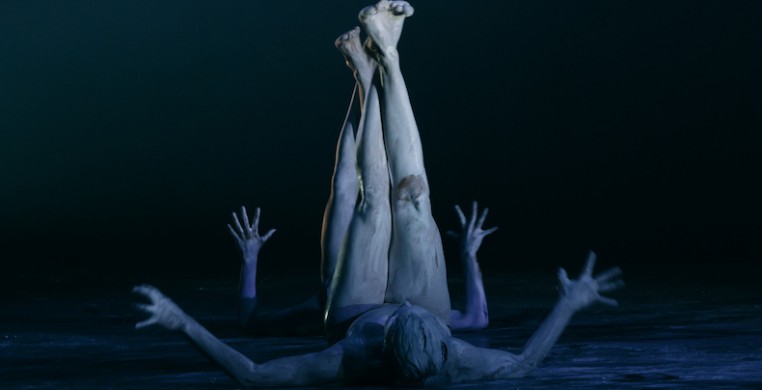It began with simple, projected text setting the framework for the dancing we were about to see, something along the lines of: “We walk in two worlds, along timelines of ancient past and contemporary society.” In this moment, the use of technology to ease an audience into stories dating back 65,000 years is not lost on me. Nor the next moment, when the tech was stripped away and the performance began with something as simple and natural as a man hiding behind brush. Then another, then BAM. The men jumped six feet into the air over the pieces of brush, moving immediately into fast chest pops, twists to the side, a slide to the floor, a pose in an earthy, stall-like position, then back into quick, athletic movement. Bangarra Dance Theatre had brought their A-game.
A dance company based in Sydney, Australia, Bangarra Dance Theatre is comprised of dancers with Aboriginal and/or Torres Strait Islander backgrounds striving to preserve their Indiginous history and culture through dance. Performing Nov 22 and 23 at the Harris Theater, Bangarra Dance Theatre shared their stories as people walking in two worlds for the first time with Chicago audiences by telling a history often neglected in the United States in a unique fusion of Aboriginal culture and contemporary dance.
The company presented two works: “Spirit,” a collection of pieces from Bangarra’s 30-year repertoire celebrating their unbroken connection with the land, and “Nyapanyapa (Our land people stories),” a complete work inspired by the textured paintings of artist Nyapanyapa Yunupingu. “Nyapanyapa” was the highlight of the evening, showcasing the company’s unique blend of theatrics, character development, preservation of history and integration of contemporary practices—all through one continuous choreographic work. With seasoned dancer Elma Kris embodying Yunupingu as she interacted with a series of her iconic pieces (brought to life by the rest of the ensemble), there was space in the choreography for moments of subtlety that, juxtaposed with the rest of the fierce and fast-paced movement, sent waves of emotion and reflection through the theater.
The concept of the duality that these artists carry as members of a contemporary society holding onto traditions of First Nations People, was present in the entire evening. The dancing was a true blend of cultures and timelines. When watching, I couldn’t tell where the Aboriginal movement ended and the contemporary began—where the shaking of the body traced back to the kangaroo (as shared in the program), and where it traced back to modern-day athleticism. Even the choice to create a piece about Yunupingu fell into this ideology: she makes bark paintings that use traditional techniques but veer from tradition in content. She paints about her own life instead of that of her ancestors, her favorite bush apples or the time she was almost gored to death by a buffalo.
But much of this context wasn’t obvious to me in the moment. Knowing absolutely nothing about Nyapanyapa Yunupingu before last night, I had to do some research to really understand the nuances of how her story fit into Bangarra’s. In fact, I didn’t feel as connected to the performance as I had wanted to. The vast amount of complex choreography, while stunning to watch, was tricky to relate to on a deeper level. But in many ways, I feel like that’s the point of seeing this performance. I recognized that it was not my story, not my culture. But as discussed in the Harris Theater’s panel discussion with Bangarra earlier this week, it’s important to witness this work to keep these ancient communities alive. From beginning to end, I was learning and absorbing the 65,000 years of Australian Indiginous history—something that’s as far from where I am now conceptually as much as it is geographically. (Never in my life would I consider the possibility of being gored by a buffalo.)
And though I couldn’t necessarily comprehend the entirety of this history in the theater, I did feel a connection to a different Indigenous story. The performance was preceded by a land attribute to the Council of the Three Fires, or the Odawa, Ojibwe and Potawatomi Nations of Chicago, along with the other Native American populations that make this city the third largest urban Native American population in the United States. These communities were on my mind as I was viewing the performance, and Bangarra’s celebration of historical culture, nature and art spurred a reminder of the tens-of-thousands-year-old stories that reside within the land on which I currently stand.
By the end of the evening, when the constantly moving choreography settled into powerful unison work which slowed into a soft settle into the floor which revealed the projected face of Nyapanyapa Yunupingu, the stage was simple and quiet. But I felt shifted. I felt the magnitude of the stories shared and the reverence for culture and heritage that Bangarra Dance Theatre brought to the stage. An amazing thing to do in such an industrial theater.
--
Bangarra Dance Theatre performs Nov 23 at at 2 p.m. (family dance matinee) and 7:30 p.m. at the Harris Theater, 205 E Randolph Dr. Tickets start at $10 and can be found by clicking the event pages below.


